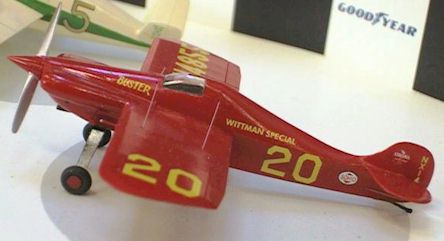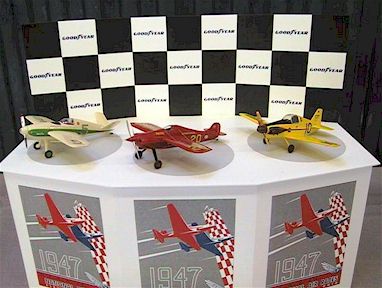by Anders Bruun
photos by Martin Waligorski and Peter Alsterberg
The years between 1929 and 1939 were hailed as ”The Golden Age of Air Racing” 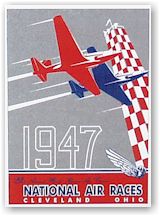 – an era of invention and adventure, when innovative individuals could build an airplane and compete in air races all around the US. However, already towards the end of the 1930s it was realized that air racing had become too expensive and too technically advanced for most home-builders. In 1940 the US Professional Racing Pilots’ Association (PRPA) took an initiative to create a competition class for small, cheap airplanes that could race around a short closed circuit that could be seen in its entirety by the spectators. Then World War II put an end to all air racing for seven years, and when air racing was reborn in 1946 the colorful fields of unique more or less homebuilt airplanes were gone. Huge advances in performance were made during the war, and fighters from the recently finished war were the only planes that had a chance of being competitive.
– an era of invention and adventure, when innovative individuals could build an airplane and compete in air races all around the US. However, already towards the end of the 1930s it was realized that air racing had become too expensive and too technically advanced for most home-builders. In 1940 the US Professional Racing Pilots’ Association (PRPA) took an initiative to create a competition class for small, cheap airplanes that could race around a short closed circuit that could be seen in its entirety by the spectators. Then World War II put an end to all air racing for seven years, and when air racing was reborn in 1946 the colorful fields of unique more or less homebuilt airplanes were gone. Huge advances in performance were made during the war, and fighters from the recently finished war were the only planes that had a chance of being competitive.
PRPA took a new look at their plans to create a cheap and simple racing class. In the end of 1946 the rules for the new class were fixed. The only engine allowed was a standard unmodified Continental C-85, an 85 horsepower four-cylinder air-cooled engine of 190 cubic inches (3.1 liters), which was used in the Piper Cub and several other light planes. The rules prescribed a minimum wing surface of 66 square feet (6.1 square meters) and a minimum empty weight of 500 lb (220 kg). Flight-adjustable propellers and retractable landing gears were forbidden. Shortly after the announcement of the new rules Goodyear agreed to sponsor the class and donated prizes for the next three year’s’ National Air Races.
The first race for these ”midgets” was the 1947 National Air Races in Cleveland. Ohio. Thirteen planes were entered, of which ten were new-built and three were converted pre-war racers. The small engines and the low minimum weight meant that the planes were very small. The pilots were practically sitting on the fuselage bottom with their feet against the firewall. Typical dimensions were wing span and length of 15-20 feet (4.5 – 6 meters). The planes raced on a rectangular 2.2 mile (3.5 km) course. After some qualification heats, a final of fifteen laps was flown.
The 1947 Podium Finishers
The final race was won by William Brennand in Steve Wittman’s ”Buster” (race number 20) with a speed of 165.9 mph (267 km/h). Brennand was made for flying these small planes – he was very small, and only weighed 105 lb (48 kg)! ”Buster” was a veteran from the pre-war races, completely fabric-covered with a steel tube fuselage and wire-braced wooden wings. Wittman had originally built the plane in 1929 and had himself flown it in dozens of races during the 1930s, until crashing it in the 1938 Oakland races. The plane, which in those days was called ”Chief Oshkosh”, had been modified several times – in 1947 it was equipped with its fourth engine and its fifth set of wings. Like many other Goodyear Trophy racers it did not have conventional 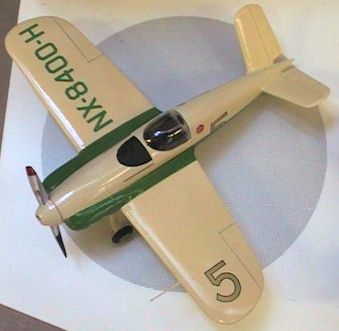 landing gear suspension, but was had flexible metal landing gear legs. Wittman had himself invented and patented this solution, which is still used on many light planes, and for several years he received license money for it. Wittman was a legendary pilot and designer of homebuilt airplanes. He continued racing his self-designed planes until the end of the 1980s. He was killed in 1995, at the age of 91, in an accident with another of his home-built planes.
landing gear suspension, but was had flexible metal landing gear legs. Wittman had himself invented and patented this solution, which is still used on many light planes, and for several years he received license money for it. Wittman was a legendary pilot and designer of homebuilt airplanes. He continued racing his self-designed planes until the end of the 1980s. He was killed in 1995, at the age of 91, in an accident with another of his home-built planes.
Second place was won by Paul Penrose in Art Chester’s ”Swee-Pea” (race number 5). He was narrowly beaten, with a speed of 165.4 mph. Chester was another of the most successful race pilots of the 1930s, and during the war years he was employed as a designer by North American Aviation. He had himself built ”Swee-Pea”, which was easily recognizable by the unusual V-tail and the spinner with its inlet for cooling air, but it was otherwise rather conventional, with a steel-tube fuselage and plywood-covered wooden wings.
Third place was taken by Herman Salmon in the Cosmic Wind plane ”Slick” (race number 10) with a speed of 158.8 mph (256 km/h). The Cosmic Wind was entirely constructed of metal.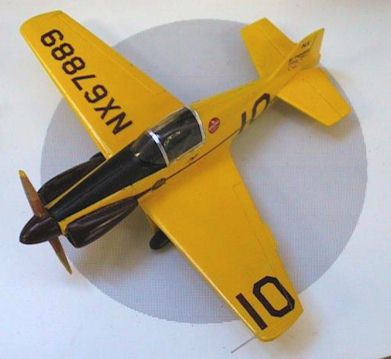 It was designed and built by a group of Lockheed employees, which included the famous test pilots Herman Salmon and Tony LeVier. They built three Cosmic Winds – LeVier took fourth place in another one (”Little Toni”, race number 3), but the last one was not finished until the following year.
It was designed and built by a group of Lockheed employees, which included the famous test pilots Herman Salmon and Tony LeVier. They built three Cosmic Winds – LeVier took fourth place in another one (”Little Toni”, race number 3), but the last one was not finished until the following year.
Formula One Air Racing
The 1947 Goodyear Trophy was the birth of a racing class which is still active. In 1948 National Air Races the number of active planes had increased to 25, and the class continued to race even when other air racing died during the Korean War. For twelve years the ”midgets” was the only surviving air racing class, and with the exception of 1961 – 1963 races have been held every year. The introduction of the Reno Air Races in 1964 and the creation of the popular home-built Cassutt III resulted in a re-birth of the class. The only major modification of the rules was made in 1968, when the somewhat bigger and stronger 100 horsepower Continental O-200 engine replaced the old C-85, which was not produced anymore and was getting difficult to maintain. At around that time the class was accepted, as the first and so far only air racing class, by FAI (the international aviation federation) and took the name Formula One. Through the years more than 150 races have been held in USA, Canada, Mexico, Britain, France and Denmark. It is planned that Formula One air racing will be part of the 2001 World Air Games in Spain. At the 1999 Reno Air Races around 20 planes were entered. First place was won by Jon Sharp in his composite racer ”Nemesis”. The fastest planes today reach speeds of 280 mph (450 km/h) in a straight line – not bad from a 100 horsepower four-cylinder engine!
The models
The models are all to 1/72 scale, which means the fuselages are about as long as your little finger. The three planes are completely scratch-built – since the original planes were rather different, they had to be built in different ways:
#20 ”Buster” was almost completely fabric-covered, so the stringers and ribs had to be simulated. The fuselage is a box of 0.5 mm plastic card and the wings were sanded from solid plastic card, all skinned with scored 0.25 mm plastic card. The tail surfaces are 0.25 mm scored plastic card, glued back-to-back. The front of the cowling ”cheeks” were made from 1 mm plastic card, but the rest of the nose shape was built up from Milliput. The spring-steel landing gear legs were made of brass sheet.
The fuselage of #5 ”Swee-Pea” was also fabric-covered, but the shape was more complex so skinning with plastic card was impossible. The fuselage was built up around a vertical 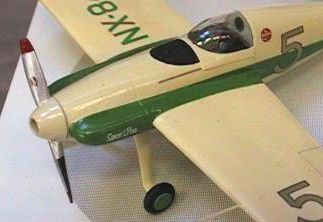 keel of 1 mm plastic card with a box section around the cockpit area. The fuselage shape was then sculpted from Milliput and sanded to shape. Wings and tail surfaces were carved and sanded from solid plastic card. The complex curved landing gear legs were made of 0.5 mm plastic card, heat-formed between two blocks of carved balsa and sanded to shape.
keel of 1 mm plastic card with a box section around the cockpit area. The fuselage shape was then sculpted from Milliput and sanded to shape. Wings and tail surfaces were carved and sanded from solid plastic card. The complex curved landing gear legs were made of 0.5 mm plastic card, heat-formed between two blocks of carved balsa and sanded to shape.
The all-metal ”Slick” was the easiest to build. The fuselage is a heavy box of 1 mm plastic card with the edges rounded off. The nose and the turtle-deck were built up from Milliput. Wings and tail surfaces were made from solid plastic card and the spring-steel landing gear legs were made of brass sheet. The front of the cowling ”cheeks” were again made from 1 mm plastic card, with the rest built up from Milliput.
The canopies of all planes were heat-stretched over plugs made from Milliput. All planes use O-rings for tires – these are the only ready-made parts used. The wheels were made from short lengths of plastic rods and punched out discs of thin plastic card. The spinner of ”Swee-Pea” was made from the tip of some kit spinner, but the other ones were turned from plastic rod, using sanding sticks and a small electric drill. The propeller blades were carved and sanded from plastic rods.
The models are painted in a mixture of gloss acrylic and 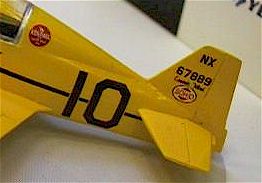 enamel paints. I like to use one type of paint on top of the other, since overspray can then easily be removed with solvent without affecting the base layer. Accurate masking of such small models is difficult, because of the small radius of curvature of the fuselages. The decals are all home-printed. They were drawn on my home computer, using Corel Draw software, and printed on Tango Papa clear decal film using an ALPS MD-1000 printer. The final coat is Tamiya gloss clear varnish, which I think has the perfect sheen for models of gloss airplanes. It is somewhere between satin and gloss – gloss enough to give a little reflection but still not gloss enough to look glassy!
enamel paints. I like to use one type of paint on top of the other, since overspray can then easily be removed with solvent without affecting the base layer. Accurate masking of such small models is difficult, because of the small radius of curvature of the fuselages. The decals are all home-printed. They were drawn on my home computer, using Corel Draw software, and printed on Tango Papa clear decal film using an ALPS MD-1000 printer. The final coat is Tamiya gloss clear varnish, which I think has the perfect sheen for models of gloss airplanes. It is somewhere between satin and gloss – gloss enough to give a little reflection but still not gloss enough to look glassy!
I wanted to enter the models in the ”Collection” class in the IPMS-Sweden Open competition, so I wanted to make a good-looking display for them. After some thinking I decided to make something on the lines of a modern Formula One car-racing podium, raised from the table surface and with a checkered background that would give a good contrast against the colorful planes. The slightly octagonal shape was chosen because I wanted something that was not just square, and again the drawing software came in handy in order to make patterns for the different plastic card parts. All the decor on the podium was printed on decal film. I had a scan of the 1947 National Air Race poster, but it was not sharp enough to print, so I had to re-create the artwork in Corel Draw before printing it. I couldn’t find the correct Goodyear font either, so I had to draw the logo from scratch.
A crazy project? Perhaps – I actually started it when I was home for a week with a cold, some seven or eight years ago. After sitting at home for a couple of days watching television I got fed up and wanted something more exciting. I had some spectacular color photos of the planes in an old issue of Airfoil magazine, and I had some Hirsch drawings of the planes and, well, why not… The start was easy, I made the basic airframe parts of all planes in two days, before returning to health. After that they sat in my cupboard, receiving only sporadic attention every second year or so. The thing that finally made me finish them was buying the ALPS printer: It prints decals – decals are of no use unless you put them on a model – so you have to finish models! I’m probably the only man in the world who has increased his modeling output by buying a computer gadget…
This article was originally published in IPMS Stockholm Magazine in October 2000.
